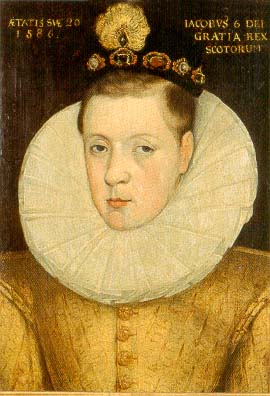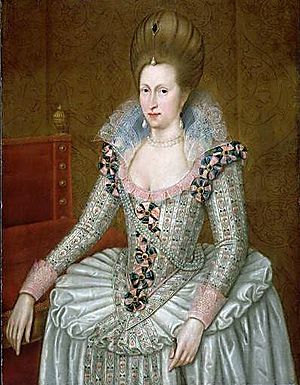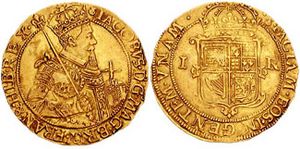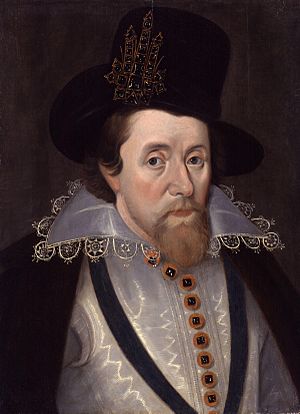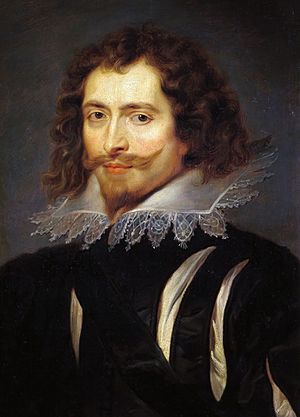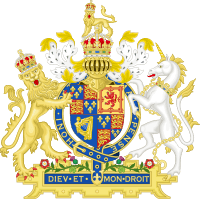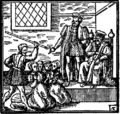James VI and I facts for kids
Quick facts for kids James VI and I |
|||||
|---|---|---|---|---|---|
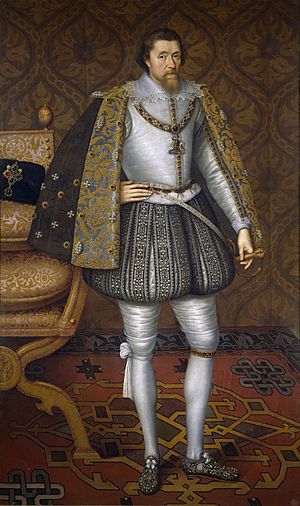
Portrait attributed to John de Critz, c. 1605
|
|||||
| King of England and Ireland (more...) | |||||
| Reign | 24 March 1603 – 27 March 1625 | ||||
| Coronation | 25 July 1603 | ||||
| Predecessor | Elizabeth I | ||||
| Successor | Charles I | ||||
| King of Scotland (more...) | |||||
| Reign | 24 July 1567 – 27 March 1625 | ||||
| Coronation | 29 July 1567 | ||||
| Predecessor | Mary | ||||
| Successor | Charles I | ||||
| Regents |
List
|
||||
| Born | 19 June 1566 Edinburgh Castle, Edinburgh, Scotland |
||||
| Died | 27 March 1625 (aged 58) (NS: 6 April 1625) Theobalds House, Hertfordshire, England |
||||
| Burial | 7 May 1625 Westminster Abbey |
||||
| Spouse | |||||
| Issue detail... |
|||||
|
|||||
| House | Stuart | ||||
| Father | Henry Stuart, Lord Darnley | ||||
| Mother | Mary, Queen of Scots | ||||
| Signature |  |
||||
James VI and I (born James Charles Stuart; 19 June 1566 – 27 March 1625) was a very important king. He was King of Scotland as James VI from 1567. Then, in 1603, he also became King of England and Ireland as James I. This event is known as the Union of the Crowns.
Even though James ruled both Scotland and England, they were still separate countries. They had their own parliaments, courts, and laws. But James was the king of both. He was the son of Mary, Queen of Scots. He was also a great-great-grandson of Henry VII of England. This meant he could become king of all three countries.
James became King of Scotland when he was just 13 months old. His mother, Mary, Queen of Scots, had to give up her throne. Several people called regents ruled for him until he was old enough. In 1603, he became king of England and Ireland. This happened after Elizabeth I died without any children. He ruled all three kingdoms for 22 years. This time is called the Jacobean era.
After becoming King of England, James lived mostly in England. He only went back to Scotland once. He called himself "King of Great Britain and Ireland". He wanted England and Scotland to have one parliament. During his rule, England started to set up colonies in America. Also, the Plantation of Ulster began in Ireland.
James was King of Scotland for 57 years. This was the longest reign for any Scottish monarch. He did well in Scotland. But he had many problems in England. These included the Gunpowder Plot in 1605. He also had many disagreements with the English Parliament.
During James's reign, literature and plays were very popular. Famous writers like William Shakespeare and Ben Jonson were active. James himself was a writer. He wrote books like Daemonologie and Basilikon Doron. He also supported the creation of the Authorized King James Version of the Bible. This Bible translation is still widely used today. James wanted peace and tried to avoid wars. He was followed by his second son, Charles.
Contents
Early Life
Birth and Family
James was the only son of Mary, Queen of Scots. His father was Henry Stuart, Lord Darnley. Both his parents were related to Henry VII of England. This made James a strong candidate for the English throne. Mary's rule in Scotland was not stable. She and Darnley were Catholics. Many Protestant noblemen were against them.
James was born on 19 June 1566 at Edinburgh Castle. He became Duke of Rothesay and Prince of Scotland right away. He was baptized in a Catholic ceremony. His godparents included Elizabeth I of England.
James's father, Darnley, was murdered in February 1567. James then inherited his father's titles. Mary, his mother, married James Hepburn, 4th Earl of Bothwell. Many people thought Bothwell had killed Darnley. This made Mary even more unpopular. In June 1567, Protestant rebels arrested Mary. They put her in Loch Leven Castle. She never saw her son again. She was forced to give up her crown. James became king, and his half-brother, James Stewart, 1st Earl of Moray, became his regent.
Growing Up with Regents

James was cared for by the Earl and Countess of Mar. He grew up safely in Stirling Castle. He was crowned King of Scots at 13 months old. This happened on 29 July 1567. He was raised as a Protestant. This was the religion of most Scottish rulers.
James had several tutors. The main one was George Buchanan. Buchanan was strict but taught James to love books and learning. He wanted James to be a king who respected limits on his power.
Mary, Queen of Scots, escaped prison in 1568. This led to some fighting. Her troops were defeated. She fled to England and was kept prisoner by Elizabeth I. James's first regent, the Earl of Moray, was killed in 1570. The next regent was James's grandfather, Matthew Stewart, 4th Earl of Lennox. He died a year later. Then came the Earl of Mar, who also died in 1572.
James Douglas, 4th Earl of Morton, became the next regent. He was very effective. But he made enemies because he was greedy. He lost power when Esmé Stewart, 1st Duke of Lennox, arrived in Scotland. Lennox became a close friend of James. Morton was later executed in 1581. James was 15 years old. He remained under Lennox's influence for about a year.
Ruling Scotland
Lennox was a Protestant. But Scottish Calvinists did not trust him. In 1582, some Protestant nobles captured James. This was called the Raid of Ruthven. They forced Lennox to leave Scotland.
After James was freed in 1583, he took more control. He passed laws to strengthen royal power over the Scottish church. Between 1584 and 1603, he created a strong government. He brought peace among the Scottish lords. His finance team, called the Octavians, tried to fix his money problems. But they faced opposition and were disbanded.
In 1600, there was one last attempt against James. He was attacked by Alexander Ruthven. Ruthven was killed in the struggle. James's story of what happened was not fully believed.
In 1586, James signed a treaty with England. His mother, Mary, was executed in 1587. James called this a "strange procedure". But these events helped him become the next king of England. Queen Elizabeth I had no children. James was her closest relative. He made sure Elizabeth knew he supported her.
Marriage and Family Life
James needed to marry to strengthen his rule. He chose Anne of Denmark. She was 14 years old and Protestant. They married in Copenhagen in 1589. Anne sailed for Scotland but was caught in storms. James sailed to Norway to get her himself. This was seen as a romantic act. They returned to Scotland in 1590.
James was very fond of Anne at first. They had three children who lived to be adults:
- Henry Frederick, Prince of Wales: He died young, at 18.
- Elizabeth: She became queen of Bohemia.
- Charles: He became king after James.
Anne died in 1619, before James.
Witchcraft Beliefs
James's visit to Denmark sparked his interest in witchcraft. He thought it was a part of theology. He attended the North Berwick witch trials in Scotland. People were accused of using witchcraft to cause storms against his ship.
James became very interested in witches. He wrote a book called Daemonologie in 1597. This book was against witchcraft. It even inspired William Shakespeare's play Macbeth. James sometimes watched the torture of women accused of being witches. But after 1599, he became more doubtful. He later warned his son, Prince Henry, to be careful about trusting accusations of witchcraft.
Ruling the Highlands and Islands
For a long time, the western parts of Scotland, the Hebrides, had been difficult to control. The kings had broken the power of the local lords. But they did not set up a new way to govern. This led to many raids and conflicts. Also, the Protestant Reformation was slow to reach these areas. This caused religious differences.
Official papers described the people of the Highlands as "barbaric". The Gaelic language was seen as foreign. The Scottish Parliament wanted to get rid of it.
In 1598, James allowed some "Gentleman Adventurers" to try and "civilize" the Isle of Lewis. James wanted them to remove the local people. The colonists failed twice. A third attempt in 1607 was more successful.
In 1609, the Statutes of Iona were passed. These laws made clan chiefs send their children to English-speaking Protestant schools. They also had to support Protestant ministers. Bards (storytellers and poets) were outlawed. Chiefs had to report to Edinburgh regularly. This was the start of trying to remove the Gaelic language and culture.
In the Northern Isles, James's cousin, Patrick Stewart, 2nd Earl of Orkney, resisted these changes. He was imprisoned. His son led a rebellion but failed. Both were hanged. Their lands were taken by the Crown.
Ideas about Monarchy
In 1597–98, James wrote two important books: The True Law of Free Monarchies and Basilikon Doron. In The True Law, he explained his belief in the divine right of kings. This idea said that kings were chosen by God. He believed kings were above other men. He said kings could make new laws. But they also had to follow traditions and God's will.
Basilikon Doron was a guide for his son, Henry Frederick, Prince of Wales. It gave practical advice on how to be a king. James advised Henry to hold parliaments only when new laws were needed. He thought parliaments were just the king's "head court". This idea would later cause problems with the English Parliament. James believed kings owned their land like a lord owns his property. He thought kings existed before laws or parliaments.
Supporting Writers
James wanted to promote Scottish literature. In 1584, he published a guide for writing poetry. He also supported music. He was the head of a group of Scottish poets and musicians. This group was called the Castalian Band. James himself was a poet.
As he got closer to becoming King of England, his focus changed. Scottish writers started to use more English in their writing. They followed James to London in 1603. James's support for writers helped shape English literature.
Becoming King of England
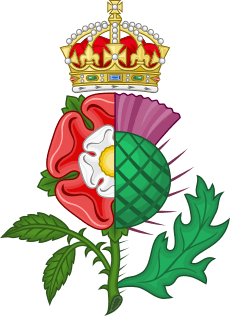
Elizabeth I was the last ruler from the Tudor family. James was her closest relative. He was expected to become the next king. English politicians, like Sir Robert Cecil, secretly wrote to James. They wanted to make sure the change of kings would be smooth.
Elizabeth died on 24 March 1603. James was announced as the new king in London that same day. On 5 April, James left Edinburgh for London. He promised to return every three years, but he never did. He traveled slowly south. People welcomed him warmly. James was amazed by how rich England was. He said he was "swapping a stony couch for a deep feather bed".
He arrived in London after Elizabeth's funeral. Many people came to see him. They were happy that the change of kings was peaceful. His English coronation was on 25 July. There were big celebrations, even though an outbreak of plague limited them.
But England had problems. The government was in debt. There had been expensive wars in Ireland.
Early Years in England
James faced two plots against him in his first year. These were the Bye Plot and Main Plot. But the change of power was mostly smooth. James kept many of Elizabeth's advisors. He also added some Scottish nobles to his council.
In his early years, the government was run by Robert Cecil, 1st Earl of Salisbury. This allowed James to focus on bigger issues. He wanted to unite England and Scotland more closely. He also worked on foreign policy. He enjoyed hunting in his free time.
James wanted to create one country called Great Britain. He wanted one king, one parliament, and one law. But both England and Scotland opposed this idea. In 1604, the English Parliament refused to call him "King of Great Britain". So, in October 1604, he used the title by proclamation instead of by law.
James was more successful in foreign policy. He had never been at war with Spain. He worked to end the long Anglo-Spanish War. A peace treaty was signed in August 1604. This was thanks to skilled diplomats. Spain wanted Catholics in England to have more freedom to worship. This caused problems for James. He was seen as too harsh on Catholics abroad. But at home, his advisors wanted him to be even stricter.
The Gunpowder Plot
On the night of 4–5 November 1605, a Catholic man named Guy Fawkes was found. He was in the cellars of the Parliament buildings. He was guarding barrels of gunpowder. He planned to blow up Parliament the next day. His goal was to kill the king, his family, and the government.
This discovery became known as the Gunpowder Plot. It caused great relief across the country. People were happy the king and his sons were safe. This event helped James get more money from Parliament. Fawkes and others involved in the plot were executed.
King and Parliament
Working with Parliament was often difficult for James. In 1604, he ended Parliament angrily. He had not gotten their support for a full union or enough money. He told them they had not done well. He wanted them to use their freedom more carefully.
As James's reign went on, his government faced money problems. This was partly due to rising prices. But it was also because James's court spent a lot of money. In 1610, his chief minister, Salisbury, suggested a plan. Parliament would give the king money to pay off his debts. In return, the king would make some promises. But the talks failed. James dismissed Parliament in December 1610.
The same thing happened with the "Addled Parliament" in 1614. James dissolved it after only nine weeks. They did not give him the money he needed. James then ruled without Parliament until 1621. He found other ways to get money. He sold titles and honors.
The Spanish Match
Another way to get money was a marriage plan. This was for James's son, Prince Charles. He was to marry Infanta Maria Anna of Spain. This was called the Spanish Match. James liked this idea because it would keep peace with Spain. This would save money on wars. James kept the talks going for almost ten years.
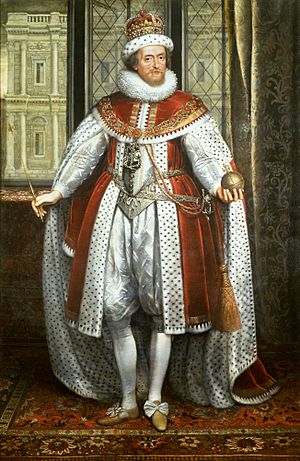
Many people in Protestant England did not trust this plan. In 1616, Walter Raleigh was released from prison. He went on a trip to South America to find gold. James told him not to fight the Spanish. But Raleigh's trip failed. His son was killed fighting the Spanish. When Raleigh returned, James had him executed. The public was angry about this.
James's plan was also hurt by the Thirty Years' War. This war started in Europe. His Protestant son-in-law was driven out of his lands. Spanish troops invaded his territory.
In 1621, James called Parliament to get money for a military trip. But Parliament did not give enough money. They wanted war with Spain instead. They also asked Charles to marry a Protestant. James told them not to interfere in royal matters. He dissolved Parliament again.
In 1623, Prince Charles and Buckingham went to Spain secretly. They wanted to arrange the marriage themselves. But the trip was a failure. The Spanish demanded that anti-Catholic laws be removed. Charles and Buckingham returned without the Infanta. They then wanted a war against Spain. They convinced James to call Parliament again in 1624. Control of policy was shifting from James to Charles and Buckingham. Parliament agreed to fund a war against Spain. This would cause problems for Charles later in his own reign.
King and Church
After the Gunpowder Plot, James took strong actions against Catholics who did not follow the Church of England. In 1606, a law was passed. It required people to take an Oath of Allegiance. This oath denied the Pope's power over the king. James was kinder to Catholics who took the oath. He even allowed some secret Catholics at his court.
In 1603, Puritan clergy asked for changes to the Church of England. They wanted to remove things like wedding rings and the term "priest". James was strict at first. But later, he was less harsh. As a result of a meeting in 1604, a new translation of the Bible was ordered. This was to fix differences in existing translations. The Authorized King James Version was finished in 1611. It is a famous work of English prose and is still widely used.
In Scotland, James tried to make the Scottish church more like the English church. He wanted to bring back bishops. But many Presbyterians strongly opposed this. James visited Scotland in 1617. He hoped to bring in Anglican rituals. His bishops passed some rules in 1618. But these rules were widely resisted. James left the Scottish church divided when he died. This caused problems for his son.
Final Years
After age 50, James suffered from health problems. These included arthritis, gout, and kidney stones. He also lost his teeth. He was often very sick in his last year. He could not visit London much. Buckingham took more control over Prince Charles.
In early 1625, James became very ill. He died at Theobalds House on 27 March. Buckingham was with him. James's funeral on 7 May was grand but messy. He was buried in Westminster Abbey. His tomb was lost for many years. It was found in the 19th century.
Legacy

Many people were sad when James died. Despite his faults, he was liked by his people. They had enjoyed peace and low taxes during his rule. James had often spent time on hunting instead of government work. His later reliance on male friends also hurt the image of the monarchy.
Some historians from the 1600s blamed James for the English Civil War. They said his belief in absolute power and his money problems led to it. They believed he gave his son Charles a dangerous idea of kingship. This led to Charles's execution and the end of the monarchy for a time.
However, more recent historians have changed this view. They see James as a thoughtful king. They point to the stability of his rule in Scotland. They also note his peaceful approach to religion and war.
Under James, the Plantation of Ulster began. English and Scottish Protestants settled there. The English colonization of North America also started. Jamestown, Virginia, was founded in 1607. Cuper's Cove, Newfoundland, was founded in 1610. James worked to unite his kingdoms. This helped create the idea of a single British state.
Titles, Styles, and Symbols
Titles and Styles
In Scotland, James was "James the sixth, King of Scotland". After 1604, he was called "James the first, King of England, France, and Ireland, defender of the faith". On 20 October 1604, he changed his title to "King of Great Britain, France, and Ireland". This title was used on coins, letters, and treaties. James called himself "King of France" like other English monarchs. But he did not actually rule France.
Royal Symbols
As King of Scots, James used the royal arms of Scotland. This showed a red lion on a gold background. It was supported by two unicorns. The crest was a lion holding a sword and scepter.
When England and Scotland united, their symbols were combined. Different arms were used for each country. This was to show which kingdom was more important.
The arms used in England showed symbols for France, England, Scotland, and Ireland. The supporters were a lion and the Scottish unicorn. The unicorn replaced the red dragon used by the Tudors. The unicorn is still part of the royal arms today. James's personal motto was Beati pacifici, meaning "Blessed are the peacemakers".
The arms used in Scotland put Scotland first. The supporters were a unicorn and a lion. The Scottish crest and motto were kept.
| Coat of arms used from 1567 to 1603 | Coat of arms used from 1603 to 1625 outside Scotland | Coat of arms used from 1603 to 1625 in Scotland |
Children of James VI and I

James and Queen Anne of Denmark had seven children who lived past birth. Three of them reached adulthood:
- Henry Frederick, Prince of Wales: Born 19 February 1594. He died at age 18, probably from typhoid fever.
- Elizabeth: Born 19 August 1596. She married Frederick V, Elector Palatine in 1613. She died at age 65.
- Margaret: Born 24 December 1598. She died at age 1.
- Charles I: Born 19 November 1600. He married Henrietta Maria in 1625. He became king after James. He was executed at age 48.
- Robert, Duke of Kintyre: Born 18 January 1602. He died at 4 months old.
- Mary: Born 8 April 1605. She died at age 2.
- Sophia: Born June 1607. She died within 48 hours of birth.
Writings by James VI and I
- The Essayes of a Prentise in the Divine Art of Poesie (also called Some Reulis and Cautelis), 1584
- Lepanto, poem
- Daemonologie, 1597
- Newes from Scotland, 1591
- The True Law of Free Monarchies, 1598
- Basilikon Doron, 1599
- A Counterblaste to Tobacco, 1604
- An Apologie for the Oath of Allegiance, 1608
- A Premonition to All Most Mightie Monarches, 1609
Images for kids
-
James in 1586, age 20 (attrib. Adrian Vanson or the school of Alonso Sánchez Coello)
-
Suspected witches kneeling before King James; Daemonologie (1597)
-
Portrait after John de Critz, c. 1605. James wears the Three Brothers jewel, three rectangular red spinels; the jewel is now lost.
-
Robert Carr, 1st Earl of Somerset, by John Hoskins, 1625–30
-
On the ceiling of the Banqueting House, Rubens depicted James being carried to heaven by angels.
See also
 In Spanish: Jacobo I de Inglaterra y VI de Escocia para niños
In Spanish: Jacobo I de Inglaterra y VI de Escocia para niños



